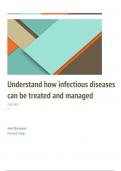Understand how infectious diseases
can be treated and managed
21.02.2023
─
Anna Dharmapuri
Richmond College
, 1
Unit/ To achieve the criteria, you MET/NOT MET
Criteria must show that you are FEEDBACK
reference able to:
Describe the method available
to treat a type of infectious
disease.
C.P4
Analyse diff erent treatment
methods to combat disease
C.M3
process.
Evaluate why treatments may
not always be accessible, or
appropriate, for particular
individuals.
C.D4
, 2
HIV/AIDS:
HIV (Human Immunodeficiency Virus) and AIDS are distinct illnesses. While HIV is the name of the virus
that causes AIDS, the full name of HIV is the human immunodeficiency virus. Acquired immunodeficiency
syndrome is the full name of AIDS. Now, HIV attacks one of our immune system's most important cells,
the T helper cells. To put it simply, HIV blocks the receptors on T helper cells that are used to identify the
foreign bodies or microorganisms that enter our bloodstream. As a result, our body is prone to diseases
and a person does not die of aids but rather from other diseases, even a small infection magnifies more
due to a weakened immune system.
In other words, our body is regularly exposed to various microorganisms daily, and our immune system
fights against them. Although ART, or anti-retroviral therapy, is the current treatment for AIDS, it does not
cure the disease.
C.P4
Instead, it significantly lowers the viral load and prevents the HIV from reproducing. The HIV virus is made
up of RNA. It is possible to reduce viral load to such an extent that a person can live a long, healthy life




